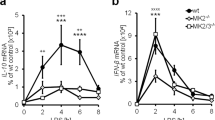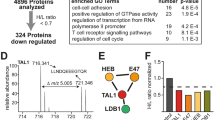Abstract
MicroRNAs are key regulators of many biological processes, including cell differentiation. Here we show that during human monocyte-macrophage differentiation, expression of the microRNAs miR-223, miR-15a and miR-16 decreased considerably, which led to higher expression of the serine-threonine kinase IKKα in macrophages. In macrophages, higher IKKα expression in conjunction with stabilization of the kinase NIK induced larger amounts of p52. Because of low expression of the transcription factor RelB in untreated macrophages, high p52 expression repressed basal transcription of both canonical and noncanonical NF-κB target genes. However, proinflammatory stimuli in macrophages resulted in greater induction of noncanonical NF-κB target genes. Thus, a decrease in certain microRNAs probably prevents macrophage hyperactivation yet primes the macrophage for certain responses to proinflammatory stimuli.
This is a preview of subscription content, access via your institution
Access options
Subscribe to this journal
Receive 12 print issues and online access
$209.00 per year
only $17.42 per issue
Buy this article
- Purchase on Springer Link
- Instant access to full article PDF
Prices may be subject to local taxes which are calculated during checkout







Similar content being viewed by others
References
Hayden, M.S. & Ghosh, S. Shared principles in NF-κB signaling. Cell 132, 344–362 (2008).
Vallabhapurapu, S. & Karin, M. Regulation and function of NF-κB transcription factors in the immune system. Annu. Rev. Immunol. 27, 693–733 (2009).
Beinke, S. & Ley, S.C. Functions of NF-κB1 and NF-κB2 in immune cell biology. Biochem. J. 382, 393–409 (2004).
Bonizzi, G. & Karin, M. The two NF-κB activation pathways and their role in innate and adaptive immunity. Trends Immunol. 25, 280–288 (2004).
Senftleben, U. et al. Activation by IKKα of a second, evolutionary conserved, NF-κB signaling pathway. Science 293, 1495–1499 (2001).
Xiao, G., Harhaj, E.W. & Sun, S.C. NF-κB-inducing kinase regulates the processing of NF-κB2 p100. Mol. Cell 7, 401–409 (2001).
Xiao, G., Fong, A. & Sun, S.C. Induction of p100 processing by NF-κB-inducing kinase involves docking IκB kinase α (IKKα) to p100 and IKKα-mediated phosphorylation. J. Biol. Chem. 279, 30099–30105 (2004).
Zarnegar, B.J. et al. Noncanonical NF-κB activation requires coordinated assembly of a regulatory complex of the adaptors cIAP1, cIAP2, TRAF2 and TRAF3 and the kinase NIK. Nat. Immunol. 9, 1371–1378 (2008).
Vallabhapurapu, S. et al. Nonredundant and complementary functions of TRAF2 and TRAF3 in a ubiquitination cascade that activates NIK-dependent alternative NF-κB signaling. Nat. Immunol. 9, 1364–1370 (2008).
Baltimore, D. et al. MicroRNAs: new regulators of immune cell development and function. Nat. Immunol. 9, 839–845 (2008).
Petrocca, F. & Lieberman, J. Micromanagers of immune cell fate and function. Adv. Immunol. 102, 227–244 (2009).
Kluiver, J., Kroesen, B.J., Poppema, S. & van den Berg, A. The role of microRNAs in normal hematopoiesis and hematopoietic malignancies. Leukemia 20, 1931–1936 (2006).
Valencia-Sanchez, M.A., Liu, J., Hannon, G.J. & Parker, R. Control of translation and mRNA degradation by miRNAs and siRNAs. Genes Dev. 20, 515–524 (2006).
Bartel, D.P. MicroRNAs: target recognition and regulatory functions. Cell 136, 215–233 (2009).
Fairweather, D. & Cihakova, D. Alternatively activated macrophages in infection and autoimmunity. J. Autoimmun. 33, 222–230 (2009).
Mantovani, A., Allavena, P., Sica, A. & Balkwill, F. Cancer-related inflammation. Nature 454, 436–444 (2008).
Johnnidis, J.B. et al. Regulation of progenitor cell proliferation and granulocyte function by microRNA-223. Nature 451, 1125–1129 (2008).
Zhao, H., Kalota, A., Jin, S. & Gewirtz, A.M. The c-myb proto-oncogene and microRNA-15a comprise an active autoregulatory feedback loop in human hematopoietic cells. Blood 113, 505–516 (2009).
Betel, D. et al. The microRNA.org resource: targets and expression. Nucleic Acids Res. 36, D149–D153 (2008).
Saetrom, P. et al. Distance constraints between microRNA target sites dictate efficacy and cooperativity. Nucleic Acids Res. 35, 2333–2342 (2007).
Grimson, A. et al. MicroRNA targeting specificity in mammals: determinants beyond seed pairing. Mol. Cell 27, 91–105 (2007).
Dejardin, E. et al. The lymphotoxin-β receptor induces different patterns of gene expression via two NF-κB pathways. Immunity 17, 525–535 (2002).
Bonizzi, G. et al. Activation of IKKα target genes depends on recognition of specific κB binding sites by RelB:p52 dimers. EMBO J. 23, 4202–4210 (2004).
Rauert, H.etal. Membrane tumor necrosis factor (TNF) induces p100 processing via TNF receptor-2 (TNFR2). J. Biol. Chem. 285, 7394–7404 (2010).
Bren, G.D. et al. Transcription of the RelB gene is regulated by NF-κB. Oncogene 20, 7722–7733 (2001).
Lawrence, T. et al. IKKα limits macrophage NF-κB activation and contributes to the resolution of inflammation. Nature 434, 1138–1143 (2005).
Li, Q. et al. Enhanced NF-κB activation and cellular function in macrophages lacking IκB kinase 1 (IKK1). Proc. Natl. Acad. Sci. USA 102, 12425–12430 (2005).
Schneemann, M. & Schoeden, G. Macrophage biology and immunology: man is not a mouse. J. Leukoc. Biol. 81, 579 (2007).
Aqeilan, R.I., Calin, G.A. & Croce, C.M. miR-15a and miR-16–1 in cancer: discovery, function and future perspectives. Cell Death Differ. 17, 215–220 (2010).
Luo, J.L. et al. Nuclear cytokine-activated IKKα controls prostate cancer metastasis by repressing Maspin. Nature 446, 690–694 (2007).
Bonci, D. et al. The miR-15a-miR-16–1 cluster controls prostate cancer by targeting multiple oncogenic activities. Nat. Med. 14, 1271–1277 (2008).
Cimmino, A. et al. miR-15 and miR-16 induce apoptosis by targeting BCL2. Proc. Natl. Acad. Sci. USA 102, 13944–13949 (2005).
Hashimoto, S.I., Komuro, I., Yamada, M. & Akagawa, K.S. IL-10 inhibits granulocyte-macrophage colony-stimulating factor-dependent human monocyte survival at the early stage of the culture and inhibits the generation of macrophages. J. Immunol. 167, 3619–3625 (2001).
Komuro, I., Yasuda, T., Iwamoto, A. & Akagawa, K.S. Catalase plays a critical role in the CSF-independent survival of human macrophages via regulation of the expression of BCL-2 family. J. Biol. Chem. 280, 41137–41145 (2005).
McDonald, P.P., Bald, A. & Cassatella, M.A. Activation of the NF-κB pathway by inflammatory stimuli in human neutrophils. Blood 89, 3421–3433 (1997).
Grossmann, M. et al. The combined absence of the transcription factors Rel and RelA leads to multiple hemopoietic cell defects. Proc. Natl. Acad. Sci. USA 96, 11848–11853 (1999).
Bours, V. et al. The oncoprotein Bcl-3 directly transactivates through κB motifs via association with DNA-binding p50B homodimers. Cell 72, 729–739 (1993).
Yamamoto, M. et al. Regulation of Toll/IL-1-receptor-mediated gene expression by the inducible nuclear protein IκBζ. Nature 430, 218–222 (2004).
Bosisio, D. et al. A hyper-dynamic equilibrium between promoter-bound and nucleoplasmic dimers controls NF-κB-dependent gene activity. EMBO J. 25, 798–810 (2006).
Basak, S., Shih, V.F. & Hoffmann, A. Generation and activation of multiple dimeric transcription factors within the NF-κB signaling system. Mol. Cell. Biol. 28, 3139–3150 (2008).
Acknowledgements
We thank the Preclinical Repository of the National Cancer Institute for the antibody to the p100 C terminus and the National Institutes of Health Blood Bank for elutriated monocytes. Supported by the Intramural Research Program of The Center for Cancer Research, National Cancer Institute, National Institutes of Health.
Author information
Authors and Affiliations
Contributions
T.L. and M.J.M. contributed equally to this work and are listed alphabetically; all authors contributed throughout each stage of the development of the manuscript (conception, design, experiments and analysis).
Corresponding authors
Ethics declarations
Competing interests
The authors declare no competing financial interests.
Supplementary information
Supplementary Text and Figures
Supplementary Figures 1–12 (PDF 1800 kb)
Rights and permissions
About this article
Cite this article
Li, T., Morgan, M., Choksi, S. et al. MicroRNAs modulate the noncanonical transcription factor NF-κB pathway by regulating expression of the kinase IKKα during macrophage differentiation. Nat Immunol 11, 799–805 (2010). https://doi.org/10.1038/ni.1918
Received:
Accepted:
Published:
Issue Date:
DOI: https://doi.org/10.1038/ni.1918
This article is cited by
-
Non-fatal outcomes of COVID-19 disease in pediatric organ transplantation associates with down-regulation of senescence pathways
Scientific Reports (2024)
-
Insight into microRNAs’ involvement in hematopoiesis: current standing point of findings
Stem Cell Research & Therapy (2023)
-
Mesenchymal stem cell-derived apoptotic bodies alleviate alveolar bone destruction by regulating osteoclast differentiation and function
International Journal of Oral Science (2023)
-
Differential impact of exportin-1-mediated nuclear export of RNAs on the RNA content of extracellular vesicle subpopulations
Biologia Futura (2023)
-
Assessment of Association between miR-146a Polymorphisms and Expression of miR-146a, TRAF-6, and IRAK-1 Genes in Patients with Brucellosis
Molecular Biology Reports (2022)



